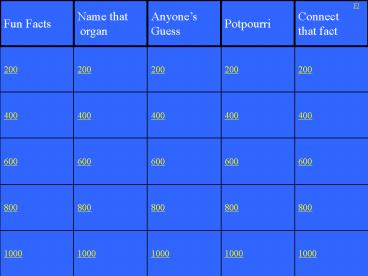Fun Facts PowerPoint PPT Presentation
Title: Fun Facts
1
Fun Facts
Name that organ
Anyones Guess
Potpourri
Connect that fact
FJ
200
200
200
200
200
400
400
400
400
400
600
600
600
600
600
800
800
800
800
800
1000
1000
1000
1000
1000
2
Scientist believe the appendix did this.
3
What is aid in the digestion of cellulose (plant
matter)?
4
This enzyme is responsible for breaking down
milk.
5
- What is rennin?
6
- If you flatten out the surface of your small
intestine it would almost cover this.
7
- What is a football field?
8
- If peristalsis is to fast in the colon the
result is this.
9
- What is diarrhea?
10
- If peristalsis is to slow in the colon the result
is this.
11
- What is constipation?
12
(No Transcript)
13
- Peristalsis
- (the circular squeeze, forward push in a wave
like motion)
14
(No Transcript)
15
(No Transcript)
16
(No Transcript)
17
(No Transcript)
18
(No Transcript)
19
(No Transcript)
20
(No Transcript)
21
(No Transcript)
22
(No Transcript)
23
(No Transcript)
24
(No Transcript)
25
(No Transcript)
26
(No Transcript)
27
(No Transcript)
28
- A middle school student won a science fair by
discussing the dangers of dihydrogen monoxide
with his classmates
29
True
30
31
(No Transcript)
32
- This is why can you eat standing on your head.
33
- Peristalsis
- (the circular squeeze, forward push in a wave
like motion)
34
- These are the two most important carbohydrates we
need.
35
- What starch and sugar?
36
- This is how food moves through the digestive
tract.
37
- What is peristalsis?
38
- Breaking down food into smaller and smaller
pieces until they can be absorbed.
39
- What is digestion?
40
- This is how active and passive transport differ.
41
- What is energy?
42
This organ has the largest internal
surface area to absorb nutrients
43
Small Intestine
44
- Hydrochloric Acid is present in this organ
45
- Stomach
46
- Minerals and water move into the bloodstream
from this organ.
47
- Large Intestine
48
Fat is broken down in this organ.
49
Small Intestine
50
- Dead cells, undigested food, and
- bacteria are stored here.
51
- Rectum
52
Final Jeopardy
- Human Digestive System
53
Final Jeopardy
- Select an organ and explain everything you know
about it
PowerShow.com is a leading presentation sharing website. It has millions of presentations already uploaded and available with 1,000s more being uploaded by its users every day. Whatever your area of interest, here you’ll be able to find and view presentations you’ll love and possibly download. And, best of all, it is completely free and easy to use.
You might even have a presentation you’d like to share with others. If so, just upload it to PowerShow.com. We’ll convert it to an HTML5 slideshow that includes all the media types you’ve already added: audio, video, music, pictures, animations and transition effects. Then you can share it with your target audience as well as PowerShow.com’s millions of monthly visitors. And, again, it’s all free.
About the Developers
PowerShow.com is brought to you by CrystalGraphics, the award-winning developer and market-leading publisher of rich-media enhancement products for presentations. Our product offerings include millions of PowerPoint templates, diagrams, animated 3D characters and more.

